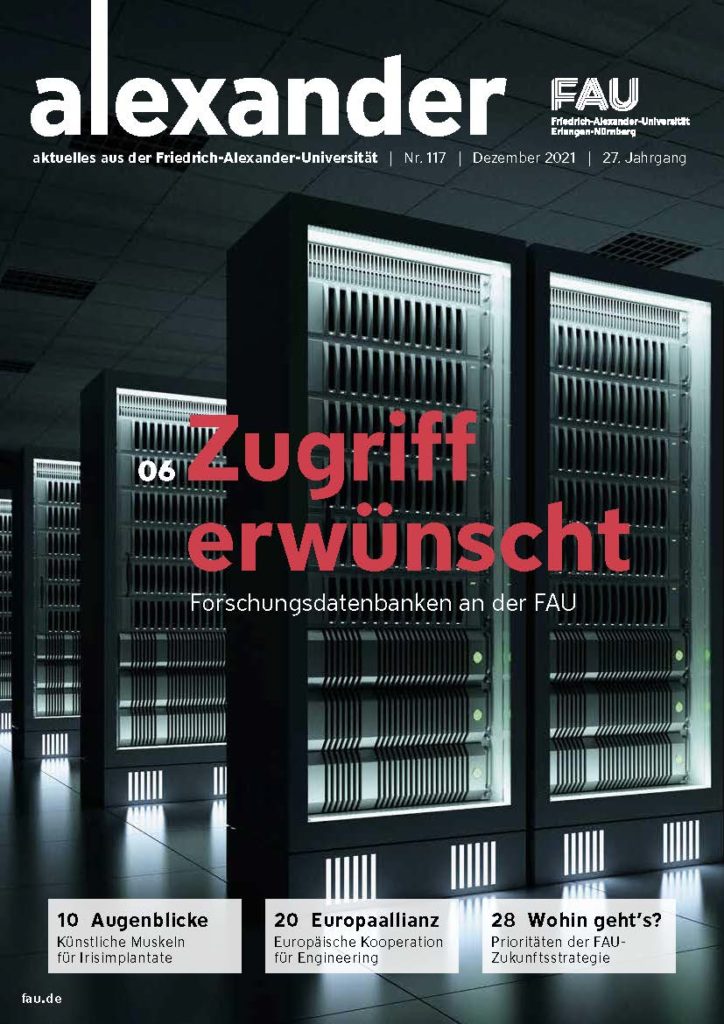Making the national team: Powering ahead with High-performance Computing at FAU
The Erlangen Regional Computing Centre (RRZE) has two new members: Alex and Fritz, the latest high-performance computers to join the team. That is not all, however. The RRZE is now one of eight National Centres for High Performance Computing (NHR) in Germany.
‘It all moved very quickly.’ Gerhard Wellein, Professor for High Performance Computing at FAU, couldn’t have put it more aptly. In April 2020, he and seven other professors from FAU submitted an application for one of the first eight new National Centres for High Performance Computing in Germany to be established at the RRZE. ‘In November of the same year we received confirmation from the Joint Science Conference (GWK), and by 1 January 2021 we were up and running,’ explains Prof. Wellein. In just a short sprint, they had made it to the national level on 1 January. Wellein talks about a ‘whole new ballgame, both when it comes to the size of the computers and the coverage we are able to offer across the whole of Germany.’
Support from federal and state governments
The Centre for National High-Performance Computing (NHR@FAU) established on 1 January 2021 is now getting ready for the long haul. The programme is initially planned to run for 10 years, with state and federal governments providing a total of 625 million euros in funding. There are good reasons for Erlangen being chosen as a location for the NHR Centre. Points in favour of the application included that broad research infrastructure was already in place and that the RRZE has already made an international name for itself in applied high performance computing. The project was also made possible thanks to the long-term support of FAU and the Bavarian State Ministry of Science and the Arts.
This project is unusual in that the state and federal governments will not only cover the costs for hardware, in other words computers and storage systems, but also technical support for users, for developing high-performance computing methods, and for advice and training from the RRZE, for an unusually long period of ten years,’ emphasises Prof. Wellein. In addition, NHR@FAU is now also in a position to establish a team to support the operation and use of the new high-performance computers. The first computer, Alex, is worth almost ten million euros and is located in the RRZE. The second computer, Fritz, is to be located in the cooling facility at the Faculty of Sciences. This computer’s modern cooling system makes it particularly energy-efficient, a further aim of the NHR programme. The team does not have the time to sit back and rest however. Long-term plans are already underway for the construction of a new, highly efficient computing centre at FAU.
Special components

Up until now, the subjects that have benefited most from HPC simulations are the scientific and engineering subjects, ranging from computer science and quantum physics to biology and chemistry, but the project has also proved valuable for subjects such as English studies and computer linguistics or newly established departments such as the Department of Digital Humanities and Social Studies (DHSS). Furthermore, members of accredited universities in Germany who have completed a doctoral degree will be entitled to file an application to access the NHR resources free of charge. This is only possible because just as much funding has been provided for expert staff as well as for hardware. The super computer uses special components such as powerful GPUs to offer higher computing power whilst consuming less energy and incurring lower costs. In order to make better use of resources, the RRZE will in future be able to employ staff specialising in simulations who are in a better position to answer specific questions.
Dr. Georg Hager, one of the experts on hand to help users with the new computers, outlines one of the possible uses for high-performance computers taken from the field of materials science. The computers can be used to simulate bonds between atoms in order to find out the properties of materials such as composite materials. The idea is that promising candidates for these materials could be identified using the computer instead of costly experiments. Or when it comes to chemistry: a working group led by Prof. Dr. Dirk Zahn, Professorship for Theoretical Chemistry, is using atomic scale simulations to investigate the wetting and dewetting behaviour of catalysts’ surfaces using ionic liquids. Wetting can significantly improve catalysis, as optimised catalysts lead to a drop in energy consumption.
Computing power versus the coronavirus
The research currently being conducted by a working group led by Dr. Eileen Socher and Dr. Phillip Arnold from the Chair of Functional and Clinical Anatomy is particularly topical. During the coronavirus pandemic, the team was able to use particularly powerful GPUs like the ones that have now been purchased for the NHR system. In their project, the two researchers used computer-based molecular simulations to investigate the interactions on an atomic level between the spike protein on the surface of SARS-CoV-2 viruses that the virus uses to attach to cells, and the human receptor ACE2. As Socher explains, the powerful computing capacities make it possible to describe the effects at the atomic level of various virus variants caused by mutations in the spike protein affecting their attachment patterns to the ACE2 receptors. When seeking to decipher the structure of the virus, the theoretical, computer-assisted approach proved considerably quicker than conducting experiments, and the results were mainly consistent. Socher believes that theoretical methods assisted by powerful computers could have a valuable contribution to time-critical research, such as the emergence of new virus variants.
Advantages for the Nuremberg Metropolitan Region
One beneficial effect of NHR@FAU is the considerable extension of FAU’s high speed access to the national research network X-WIN. It is not only FAU itself that benefits from the greater bandwidth for the internet, but rather the region as a whole, in particular Nuremberg, Erlangen and Fürth. The establishment of NHR@FAU and the projects that are currently in the pipeline for the renovation of the computing centre underline Erlangen’s central role. Preparations are already underway to connect the future Technical University in Nuremberg to the data network, IT services and modern computing facilities available there. Prof. Wellein says this follows the direction indicated by the Bavarian Council of Ministers during a meeting in Nuremberg in 2019. ‘The region is strengthening its profile as a key hub for computer science and expertise.’
from Herbert Fuehr
Technical corner

The topics of the new issue are: Database systems and research at FAU, iris implants made from artificial muscles, a drug against Long-COVID, the European University EELISA, in which universities from Europe have joined forces to think engineering further, the second part of our series on FAU strategy, the new Green Office and much more.
read more